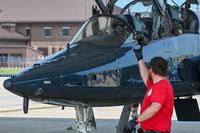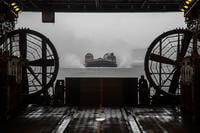Northrop Grumman Corp. is pursuing a contract to build a fleet of stealthy, carrier-based drones for the U.S. Navy while it explores commercial uses for the technology, a vice president said.
The successful landing last month of an experimental drone aboard the deck of an aircraft carrier was one of the Falls Church, Va.-based company's many firsts in the history of unmanned aviation, according to Thomas Vice, a corporate vice president and president of Northrop's aerospace systems unit.
"Because of our learning and our experience and investments we have made in this technology, we are very focused on competing and winning the UCLASS program," he said during a news conference today at the National Press Club, referring to the Navy's Unmanned Carrier-Launched Airborne Surveillance and Strike effort to build an armed, carrier-based drone fleet.
As the U.S. and other countries take steps to let unmanned systems fly in domestic airspace, Northrop is also considering expanding its drone business to include commercial work, from transporting cargo over long distances to mapping ice flows in the Arctic for energy companies, Vice said.
The technology "is an area where we see tremendous market growth, domestically and internationally," he said. "It represents a significant part of our company's revenue."
Northrop in 2012 had $25 billion in revenue, a 4.5 percent decline from the previous year. The company's aerospace systems unit, which includes unmanned, space and missile systems, accounted for $10 billion, or 40 percent, of total sales, which was flat from the prior year.
Northrop built two experimental drones, called X-47B, for the Navy's Unmanned Combat Air System Demonstrator program, known in military parlance as UCAS-D, which cost $1.4 billion over eight years.
One of the bat-winged aircraft on July 10 landed aboard the USS George H.W. Bush while the ship was sailing in the Atlantic Ocean, about 70 miles off the coast of Virginia Beach, Va.
Vice didn't clearly explain why the other plane was unable to perform the same feat in a later test.
"There's not an inherent difference that one is old technology and one is new," he said. "It's just how ... we positioned these two to create and accomplish a number of tests."
Northrop, which also builds the Air Force's Global Hawk drone -- the largest unmanned aircraft in the fleet -- is squaring off against other defense giants for the Navy's UCLASS program, including Lockheed Martin Corp., Boeing Co. and General Atomics Aeronautical Systems Inc.
The Navy recently awarded each of the companies a $15 million contract to develop designs for the program. The service plans to hold a competition in 2014 and pick a winner by the end of next year to begin developing the systems.
Vice didn't say how automatic budget cuts may affect the effort. The reductions, known as sequestration, will slice about $52 billion from the defense budget in fiscal 2014, which begins Oct. 1 -- and $500 billion over the next decade -- unless the White House and Congress come up with an alternate plan.
"My crystal ball isn't any better than yours," he said. "We all realize the great focus our customer has on affordability, the budget constraints our nation has."
Regardless, Vice said Northrop continues to invest in research and development of unmanned systems, including technology to sense and avoid other aircraft in the sky. The company also supports the Federal Aviation Administration's plan to come up with rules to integrate drones into federal airspace by 2015 and sees potential for more commercial business, he said.
"Other corporations that may be doing things in the Arctic probably have a need for surveillance," he said. "The business model, I think, is still shaping up."









